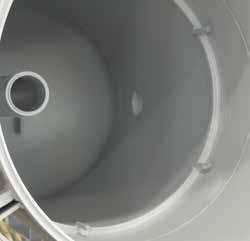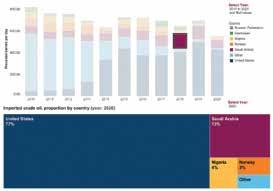How to develop EOR technologies more efficiently with a stage-gated approach BY PETRO NAKUTNYY, DIRECTOR OF OPERATIONS, EOR PROCESSES, SASKATCHEWAN RESEARCH COUNCIL next stage or identify if further work is required, cycling the technology back through the previous stage. This process prioritizes early evaluation of factors that are most likely to cause a technology to fail. If a technology is not likely to succeed, it can be cancelled at the lowest possible cost in time and resources. First, a comprehensive roadmap is developed that can realistically take a new technology or concept from the drawing table all the way to the field. It’s a six-step approach that SRC has applied to several new technology developments and start-ups. These six steps are, of course, tailored to the experiment goals.
Core flood.
I
The approach starts with identifying
t’s OK to fail in technology devel-
develop their technologies and eval-
opment. But it’s important to do it
uate technical, market and commer-
quickly and move on.
cial factors. This helps our clients save
the mechanisms and possible failure factors, so that they can be addressed as soon as possible. If it makes sense to proceed, the next step is designing
When industry is developing
time and accelerate adoption. We
new technologies to apply in the field,
operate across the whole spectrum
there are a lot of factors that go into
of technology readiness levels, from
the process — from concept to com-
concept-feasibility to field commer-
mercialization. At different points
tal design, including factors such as
cial pilots.
model size, aspect ratio, injection and
and performing small and large-scale experiments. It is very important to choose the appropriate experimen-
along the way, specialized expertise
Stage-gating technology develop-
can be useful to keep the process on
ment creates a roadmap for evaluat-
Once the experimental setup is
track and reduce development costs,
ing the field and the proposed tech-
chosen and prepared, several of the
as well as make the most efficient use
nology at key points during the pro-
experiments are run and what is of-
of time. This helps to de-risk the tech-
cess. SRC has developed fast-to-fail
ten found is that the initial idea needs
nology development process.
tools that allow us to quickly test new
significant modification for the technology to succeed.
production wells.
The Saskatchewan Research Coun-
ideas and identify any showstoppers.
cil (SRC) uses a stage-gated approach
The review will either confirm the
The next step is numerical simu-
to help small-to-medium enterprises
technology is ready to advance to the
lation and because it’s already been
26 Saskatchewan Oil Report 2021









